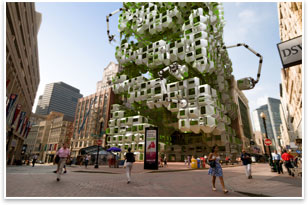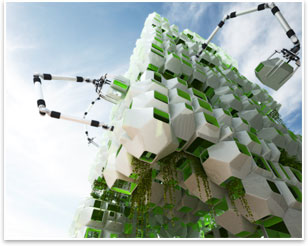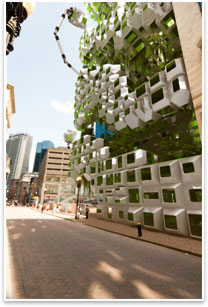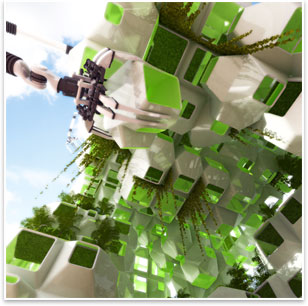
| Howeler + Yoon’s Eco-Pods Bring (Green) Industry Back to the City The foundation of a sustainable economy, built from the wreckage of an unsustainable one. How do you . . . take advantage of disused infrastructure to generate sustainable energy? Summary: For some architects, today’s convergence of economic catastrophe with greater awareness of sustainable design has prompted a reactionary vision of architecture based on humility, restraint, and timidity. Buildings that use earth berm walls to hide into hillsides using the simplest, unrefined materials can re-teach the design community how to create enclosure that once again exists in balance with nature and the economy. But, by relying on design techniques first forged by pre-agricultural humanity, they give little indication of how architecture can express its own sense of sustainable modernity. 
Images courtesy of Howeler + Yoon Architecture. Howeler + Yoon’s Eco-Pods attach to existing, abandoned building structures. Howeler + Yoon Architecture’s Eco-Pod design for an abandoned high rise husk in downtown Boston suggests no such penitent restraint. With an unfettered optimism that science can solve both the nation’s economic struggles and energy consumption issues, the young Boston firm offers a design that turns a stalled husk of former boom-time construction into a site of carbon neutral energy generation via modular units that grow algae for biofuels. With this innovative solution for ailing ecologies and economies, Howeler + Yoon re-appropriate urban verticality, taking it from unsustainable economic hubris to a beacon of inventive, infrastructural sustainability. Green infrastructure In the contemporary sustainable design movement, it’s become common to propose infrastructure that promotes urban farming, but Howeler + Yoon go a step further with their Eco-Pods by promoting industrial power generation in cities. Though the technology for the Eco-Pods could be deployed anywhere, the initial site the firm has considered is on Washington St. in downtown Boston, along a stretch of declining retail shops. The site was first home to the flagship store of clothier Filene’s Basement. The store closed in September of 2007, according to the Boston Globe, and developer Gale International bought the site and tore down the building with the intention of building a 32-story luxury condo and office tower. By July 2008, the project had stalled completely when banks rescinded their funding for the project, leaving a five-story hole in the ground and a partial skeletal façade during a worsening economy that made credit a scarce commodity. Howeler + Yoon (whose office is nearby) has proposed a system of pre-fabricated algae bioreactor modules that slot into the remaining building’s shell. Algae bioreactors contain nutrient-infused water that can be exposed to LED lighting and natural sunlight to grow algae rapidly. This algae would then be separated into natural oils and other organic byproducts via mechanical crushing or chemical solvents. Algae oil can then be refined into fuel (most likely off-site, in the case of the current Eco-Pods design), much the same way that soybeans are refined into biodiesel. 
The design calls for mechanical arms that manipulate the prefabricated pods. The Eco-Pods project is porous and open and could reach up to any building height. Howeler + Yoon envision that the spaces where pods are not slotted into the structure could be used for algae biofuel research and development or simply vertical park space, with walls covered in other kinds of flora. The site is near the city’s Boston Common park and draws a sharp counterpoint to that park's naturalistic expressions of plant life in a city and the Eco-Pod’s technologically managed ideas about green. “We like the idea of placing an ‘unnatural green’ in this vertical tower,” says Eric Howeler, AIA. By co-mingling public and industrial programs, the project also asks visitors to reconsider the separation between regular, gray infrastructure (bridges, factories, seaports) and green infrastructure like parks that are more commonly considered amenities, not necessities. As Howeler points out, requiring green infrastructure in cities may be an overlooked idea, but it’s not a new one. “Definitely, Frederick Law Olmstead would regard Central Park or the Emerald Necklace in Boston as a piece of infrastructure,” he says. The project would use mechanical arms to manipulate its pre-fabricated algae units. These arms could move and rotate modules for ideal exposure to sunlight. They’re also meant to make the system more flexible and adaptable than the structures they’ve attached themselves to. The arms will allow the Eco-Pods to be deployed quickly, and, should a building husk’s original funding be re-secured, quickly removed and sent to another location. There are many potential sites. Emporis reports that worldwide there are nearly 150 stalled skyscraper projects. In the United States, there are 29. Perhaps most notable is AIA Gold Medal Winner Santiago Calatrava’s 150-story Chicago Spire. Frozen credit markets and a generally risk-averse business climate have leveled many projects, yet the world’s tallest building (SOM’s 162-story Burj Dubai) still waits to be topped off, virtually guaranteeing that sky-piercing buildings will be a vibrant symbol of the excesses of a booming economy for years to come. Your place in the chain Howeler + Yoon (which designed the Eco-Pods project with Squared Design) got involved with the Filene’s site because of a Boston Globe call for design interventions in abandoned building sites. After a one-week charrette, the firm submitted its design, which quickly drew the attention of the architecture and sustainability blog community. This visibility even earned them a call from an algae growers association asking how they could help the architects implement their design. 
The pods attach to the building structure irregularly, creating masses and voids that could be used for algae biofuel research and development or vertical park space. All this interest has spurred Howeler to do more research on algae biofuels, and now he says he knows enough about it to hope that it’s feasible to build in several years. Today, more research needs to be done, and the refinery infrastructure still lags behind production capacity, but the bright-eyed research optimism particular to academia has deeply penetrated Howeler’s firm. Meejin Yoon, Howeler’s chief collaborator and wife, teaches at MIT, where other researchers are investigating algae’s use as a biofuel. “At MIT anything’s possible,” he says. “There’s an attitude that is really about technology being ubiquitous and research being ubiquitous.” Traditional fossil fuel energy companies have been taking notice of algae biofuel's potential as well. In July, Exxon announced that it was going to invest $600 million in the development of algae biofuels, according to the New York Times. A month later, BP announced a $10 million investment in algae. Algae’s biofuel potential is based on its speedy growth and minimal space requirements. Its feed stock is simple and plentifully available (sunlight, water, and carbon dioxide, which can be fed to algae from industrial emissions). Via photosynthesis, the plants emit oxygen on an industrial scale. Algae biofuels are also carbon neutral. When they’re burned, they only emit the carbon dioxide that they absorbed as they grew. Algae grows 20 to 30 times faster than typical crops, according to Reuters, and yields up to 30 times more energy per acre than any other fuel crops. Most importantly, algae requires no arable land and can be stacked vertically, making it the ideal urban biofuel. Its ability to be publicly accessible in urban settings means that the Eco-Pods project can give people a better understanding of the energy consumer chain, their place within it, and what needs to be done to make it more sustainable. “We’re trying to make it tangible,” Howeler says. “They’ll understand sites of production and sites of consumption. They’ll understand the relationship between the two. We like the idea that the research doesn’t happen in a lab removed from the city, but actually in the city.” A sustainable economy Though the Eco-Pods deal with a very contemporary set of problems, they’re inspired by some of architecture’s most wild-eyed thought experiments about human habituation, modularity, and flexibility from the mid-20th century. The Eco-Pods honeycombed, geometric patterns of mass and void remind one of the 1960s designs of the British Archigram collective, or even of AIA Gold Medal Winner Buckminster Fuller’s work, albeit with a contemporary and stylish juxtaposition of glossily machine-like units huddled onto gritty, discarded industrial remains. “We wanted to update some of those images from the 1960s,” like Archigram, says Howeler, who calls the project an “overlay of contemporary cultural ambitions and anxieties.” 
The algae bioreactor pods may contain nutrient-infused water that is exposed to LED lighting and natural light. One such anxiety is the loss of American industry from urban centers and from the country in general, and the creeping suspicion that economies that don’t make things anymore can’t last for long. Most American cities were founded as hubs of industry, which helped power the explosive growth of suburbs in the middle of the 20th century. In part, people left cities to escape the belching black clouds of factories and industry. Ironically, industry often followed them, looking for the same thing: cheaper land and open space to build on. Globalism and other structural changes to the economy continued to sap domestic industry’s foothold, and cities and the industrial economy lost ground together. Cities’ nascent renaissance has had some success luring people back to urban centers with better investments in housing and green space. A USA Today report recently revealed that growth rates in central cities are starting to outpace their suburban counterparts. But industry has not followed en masse. Cities have been recast as cosmopolitan playgrounds for creative professionals (scientists, educators, writers, artists, entertainers, and, of course, architects), and there is little call to put up waterfront shipyards where kayaks could be rented on a summer day, or build smoke stacks that block skyline condo views. Indeed, many former industrial sites are being redeveloped as urban parkland. But it seems like more than a coincidence that as this transition began accelerating, the economy foundered, in part, because of a “new economy” largely based on the misuse of complicated, poorly understood, completely abstract financial “products” that had taken the place of actual goods manufacturing in the contemporary economy. After the crash, cities are still conceding industry. With a new sustainable paradigm (“it’s not a behemoth belching smoke, but belching oxygen,” says Howeler), Eco-Pods look to reverse that. |
||
Copyright 2009 The American Institute of Architects. All rights reserved. Home Page |
||
home
news headlines
practice
business
design
recent related
› Knitting the City Back Together from Gray and Brown, with Green
› Constricted Credit Still Putting the Squeeze on Architecture Firms
› Shovel-Ready Skills: Architects are Integral to Infrastructure
See what the Committee on the Environment Knowledge Community is up to.
Visit the AIA government advocacy Rebuild and Renew Web site.
Visit the AIA’s Navigating the Economy Web site.
Do you know the Architect’s Knowledge Resource?
The AIA’s resource knowledge base can connect you to the tip sheet on moss and algae on roofs by Linda Reeder, AIA.
From the AIA Bookstore: Refabricating Architecture by James Timberlake, FAIA, and Stephen Kieran, FAIA. (McGraw Hill, 2004).
